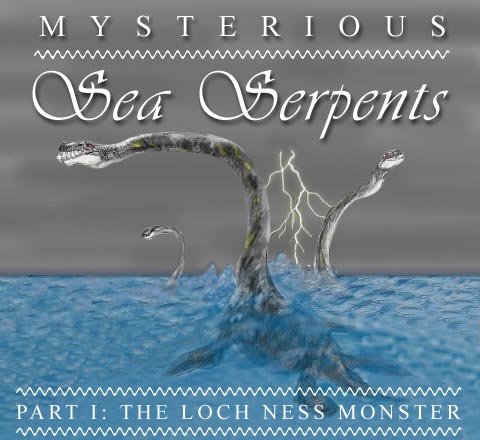
Editorial
|
Fragments
|
Shasta I
|
Sea Serpents I
|
Atlantis I
Register
for our new Hall of Records Newsletter!
Questions? Comments? Suggestions? Advertising? Press Releases?
Contact us!
Mysterious Sea Serpents Part II: Champ
|
Part III: Ogopogo
Part IV: The Search Continues
Sea Serpents in Antiquity
|
Sea Serpents in Modernity
|
The Loch Ness Monster
Sources of Deception
|
The Search Today
|
Visiting Loch Ness
|
Links
|
Books
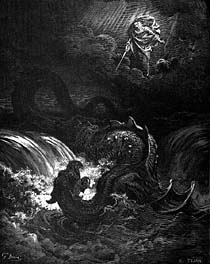
|
Dore's interpretation of the combat between God and the sea dragon Leviathan that will take place in the end times,
as described by Isaiah:
"In that day the Lord with His sore and great and strong sword shall punish Leviathan, the piercing serpent,
even Leviathan, that crooked serpent; and he shall slay the dragon that is in the sea." (Isa. 27:1, KJV)
|
 he depths of the sea have always conjured fear in the hearts of mankind. The sea's inpenetrable deep, in the minds of many ancient peoples, was the place where the forces of chaos reigned, a vast womb from which evil was spawned. It was also believed to be the entrance to the underworld, the
Abyss.
The Abyss was believed to be inhabited by many strange creatures, but its most famous inhabitant was the great sea dragon
Leviathan.
he depths of the sea have always conjured fear in the hearts of mankind. The sea's inpenetrable deep, in the minds of many ancient peoples, was the place where the forces of chaos reigned, a vast womb from which evil was spawned. It was also believed to be the entrance to the underworld, the
Abyss.
The Abyss was believed to be inhabited by many strange creatures, but its most famous inhabitant was the great sea dragon
Leviathan.

Leviathan is mentioned frequently in the Bible, and is described as being so powerful that it had actually fought with God Himself at the Creation (
Ps. 74:12-14;
c.f. also
Isa. 27:1).
The Bible also describes Leviathan as "playing" in the ocean (
Ps. 104:26).
Job 41
discusses Leviathan in great detail, describing the creature as being so massive that no man could ever hope to catch it. His scales are described as thick and tightly bound together, incapable of being penetrated by the weapons of man. Leviathan is also described in the current text of Job as breathing fire, and as making the mighty sea froth like a pot of ointment, so great is its size. "Lay thine hand upon him, remember the battle, do no more!"
(Job 41:8,
KJV)
Many other ancient peoples also believed in sea serpents that inhabited the deep, the most famous of which was Tiamat of the
Babylonian mythos.
The Babylonians believed that the sea dragon Tiamat fought against their high god Anu (later Marduk)
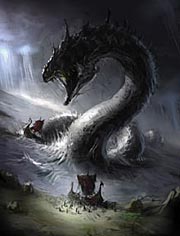
|
The Midgard Serpent, who will battle Thor at the battle of Ragnarok, according to the Norse myth. From
The World of Midgard
Copyright © 2001 Funcom All rights reserved.
|
at the creation of Earth just as the Hebrews believed Leviathan fought against God at the Creation.
The
Greek myths
told tale of the
Hydra
(lit., "water snake"), which lived in a swamp near the city of Lerna, thus becoming known as the "Lernean Hydra", a multiheaded monstrosity that killed men with its poisonous breath, blood and bite. This monster was later killed by Hercules as one of his
Twelve Labors.1
The later
Norse myths
told the tale of a giant serpent named Jormangund, or
"The Midgard Serpent". The Midgard Serpent had been thrown down from heaven by Odin, the chief god of the
Norse pantheon,
to the sea, as he feared its great power. In the sea it grew to such tremendous size that it encircled Earth at the equator (approximately 25,000 miles), so huge that the churning of its coils created the tsunami and storms that kill sailors. It was believed that the Midgard Serpent would die at the hands of Thor, the son of Odin, at the final battle of
Ragnarok2.
A similar fate awaits Leviathan
(Isa. 27:1;
Rev. 12;
13;
20:2)
The legend of the mysterious sea serpents, therefore, has a history that stretches into the furthest depths of ancient antiquity.

The watery deep even today remains a place of great mystery, and of fear, as much of Earth's vast oceans have yet to be explored. Some scientists admitting that entire species of animals may still await discovery and classification. Newly discovered species of undersea life, such as the
"Megamouth"
shark, as well as older species previously thought to be extinct, such as the
Coelecanth,
are constantly being caught and categorized as man's curiosity and technology take him ever deeper into new zones of animal life beneath the waves. Bits of evidence are being found around the world, as more and more people claim to see sea serpents and lake monsters of various types year after year. It is no wonder, then, that sightings of sea serpents are still being reported regularly, as we have only scratched the surface in our understanding of the ocean's great deep.
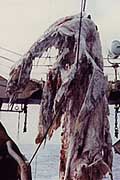
|
|
The Zuiyo Maru Plesiosaur carcass, actually that of a basking shark.
|
One of the more prominent finds of recent times has been the controversial
"Zuiyo Maru Plesiosaur". Named after the Japanese fishing trawler that had allegedly dredged up a plesiosaur carcass off the coast of New Zealand, the unusual catch looked for all the world to be the rotting carcass of a plesiosaur, with what appeared to be flippers and a long neck surmounted by what appeared to be a small head. Though the rotting carcass was thrown overboard due to health concerns, pictures of the carcass and samples of the fibrous materials were quickly taken by an alert officer for later analysis before the carcass was discarded. Though the pictures are fairly convincing,
later analysis
proved conclusively that the Zuiyo Maru carcass was not a decayed plesiosaur, but in fact a dead basking shark in an advanced state of decay, the jaws and gills having fallen away in a decay pattern typical of this type of animal.

|
|
Commemorative Japanese stamp issued in 1977 in honor of the alleged discovery.
|
However, the initial finding was so exciting that it touched off a Plesiosaur craze in Japan, despite the fact that the find had not been
proven. What is perhaps the most interesting lesson to be learned from this experience is that it helps illuminate the deepness
of the yearning within the human psyche to believe in the existence of these
cryptids.
The intense belief in the existence of sea serpents appears to be a part of the human experience. Though to date no concrete proof has been found of the modern existence of these creatures, much time and effort has been — and continues to be — spent in search of them. The fact that they existed in the past, coupled with the survival of such species of ancient fish such as the coelecanth, fill would-be
"monster hunters"
with the hope that they might someday be given the honor of having discovered — or rediscovered — a living, breathing sea serpent.

The most famous example of the modern obsession with mysterious sea serpents is the Loch Ness Monster, commonly referred to locally as "Nessie". A classic "lake monster", Nessie has a long history, with sightings going many centuries. The earliest recorded sighting occurred in 565 a.d., when a priest by the name of
St. Columba
came to Scotland to evangelize the
Picts.

|
|
St. Columba, 521-597 a.d.
|
When evangelizing near Loch Ness, St. Columba came across a group of Picts who were burying a man whom they say had been ravaged by a "monster
of the water", whereupon the saint resurrected the man by laying his staff across his chest. A second story describes another incident where
one of St. Columba's followers swam out into the loch to retrieve a boat that had drifted away, when the monster suddenly
surfaced and rushed at him with a roar. Seeing the creature, St. Columba called upon his followers to be still, and rebuked the monster in the name of Christ, whereupon the beast immediately receded,
"as if pulled by ropes".
St. Columba was credited with a number of miracles over animals. Steuart Campbell explains in his excellent
The Loch Ness Monster: The Evidence,
The episode forms part of a collection of stories demonstrating the saint's power over animals; it is preceded by a story of his power
over a wild boar and followed by an account of how he neutralized the poison of snakes. [The] purpose
was to show that the saint and his religion were more powerful than the religion of the native pagan culture. Since this latter culture
was largely based on worship of elements associated with water, domination of a water beast (even if it had never been seen) subsumed
domination of the culture based on them.3
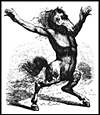
|
|
A kelpie, a devil in Scottish folklore believed to inhabit lakes and rivers.
|
This belief was based upon local myths that held that Loch Ness (and every lake in Scotland) was inhabited by a kelpie, or
"water horse". It was believed that the kelpie was an evil spirit that delighted in luring swimmers to their death by drowning them. This
may explain why in many sightings, Nessie is described as having a horselike head, with a mane of flowing hair — either the creature does
indeed have a horselike head, or many of the sightings were biased by the fact that the viewers were expecting to see a horselike head, just
like the kelpie. Unlike the kelpie, however, Nessie seems to be harmless, even benevolent, and when people do see Nessie up close, either on the land or in the water, the creature invariably flees.
Sightings
since Columba have been numerous, anywhere from a few humps in the distant waters to close encounters with a massive creature on the roadways surrounding the loch. Before the roads were built, Loch Ness was extremely remote, so sightings were exceedingly rare and poorly documented. However, once the roads were built around the loch, predictably, sightings greatly increased. Not only did sightings of the creature increase dramatically, but the creature was even occasionally seen crossing the roads late at night, bounding like a seal into the loch to avoid oncoming traffic. Some speculate that Nessie's occasional land appearances were migratory in nature, or perhaps to lay eggs. Witnesses to these events describe Nessie as massive, some 40-60 feet in length, with a gray, elephantlike hide, a long, tapering tail and a small, eel-like head on the end of a long, tapering neck — a classic plesiosaur shape.

|
|
The classic "Surgeon's Photo", believed by some to have been hoaxed.
|
Water-based sightings
are of course numerous, numbering in the thousands. One man who has purported to have seen Nessie on 18 different occasions was Alex Campbell,
a local game warden, or "water bailiff". The first time he saw the creature was in May of 1934, when it appeared moving through a canal, apparently chasing after a run of salmon. He reckoned that the creature that he saw at that time was about 30 feet long, with a 6-foot neck and gray skin. Another famous witness was R.K. Wilson, the man who took the famous "Surgeon's Photo", known throughout the world. The photo, which purports to show Nessie's head and neck above the water, was for years touted as definitive evidence of the existence of the Loch Ness monster, but was more recently exposed as a fraud. For example, the size of the wavelets around the "monster's" neck are far too small for a creature of the size that Wilson claimed to have seen. Reproductions of the image were easily made by placing a toy submarine ("clockwork submarine" in Britain) in the shallows with a fake Nessie head on top. This was in fact the method that was originally used to fake the image, according to some, though diehards still disagree.

Though many eyewitness accounts, even images and films, have no doubt been deliberately faked in order to gain notoriety, most are probably simply the result of faulty perception. Numerous accounts from people who were sure that they had seen Nessie were later dismissed as logs,
mats of seaweed, prominent waves, common animals, boats or simply floating debris tossed and turned by the wind and the waves.
 Water-Based Deceptions.
Many would-be Nessie sightings are actually just prominent waves. Quite often in lakes such as Loch Ness, the waves reflecting off of the lake's often steep shorelines can create what is called a "standing wave" effect in or near the center of the lake, causing prominent waves to appear to stay in more or less the same position for long periods of time. To the untrained eye, such waveforms can appear to take on the appearance of a partly submerged creature with one or more "humps", or even a writhing serpent breaking the surface, and have been known to fool even experienced observers. Other
unusual waveforms
include "windrows" that can be created by sustained winds;
seiches,
waves created by earth tremors that can exibit quite unusual characteristics; and boat wakes, which are capable of creating particularly interesting effects.
Water-Based Deceptions.
Many would-be Nessie sightings are actually just prominent waves. Quite often in lakes such as Loch Ness, the waves reflecting off of the lake's often steep shorelines can create what is called a "standing wave" effect in or near the center of the lake, causing prominent waves to appear to stay in more or less the same position for long periods of time. To the untrained eye, such waveforms can appear to take on the appearance of a partly submerged creature with one or more "humps", or even a writhing serpent breaking the surface, and have been known to fool even experienced observers. Other
unusual waveforms
include "windrows" that can be created by sustained winds;
seiches,
waves created by earth tremors that can exibit quite unusual characteristics; and boat wakes, which are capable of creating particularly interesting effects.
 Floating Objects.
Floating debris and plant life form probably the second most common "Nessie-like" apparitions to fool onlookers hoping to be the one to discover Nessie. Of this type of apparition, floating logs, and even whole trees, are the most common. Moreover, rotting logs filled with
methane and related gasses can rocket to the surface, buoyed by the gas created by their putrefaction, creating the spectacle of a "monster"
breaking the surface. This phenomenon has been documented in other lakes around the world as well. Logs embedded in mats of floating vegetation can provide particularly convincing monsters, as can floating debris such as oil drums and of course boats, under the right weather and lighting conditions.
Floating Objects.
Floating debris and plant life form probably the second most common "Nessie-like" apparitions to fool onlookers hoping to be the one to discover Nessie. Of this type of apparition, floating logs, and even whole trees, are the most common. Moreover, rotting logs filled with
methane and related gasses can rocket to the surface, buoyed by the gas created by their putrefaction, creating the spectacle of a "monster"
breaking the surface. This phenomenon has been documented in other lakes around the world as well. Logs embedded in mats of floating vegetation can provide particularly convincing monsters, as can floating debris such as oil drums and of course boats, under the right weather and lighting conditions.
 Common Animals.
Various types of animals have also been mistaken for Nessie, from flocks of birds to the common otter. A flock of birds flying near to the surface of the lake can cause spray to whip up and create the illusion of a many-humped creature moving near the surface. Deer have been known to swim across the loch, and the short antlers of immature bucks may explain some of the "horned Nessie" sightings that have been recorded. Otters are also fairly common in the loch, and have been known to grow up to six feet long. They also can rear up in the water, creating the classic "head and neck" appearance typical of Nessie sightings, and their thrashing about in search of prey can cause significant disturbances in the water that could be mistaken for a creature surfacing. Seals, which display similar characteristics, are also occasionally seen in the loch.
Common Animals.
Various types of animals have also been mistaken for Nessie, from flocks of birds to the common otter. A flock of birds flying near to the surface of the lake can cause spray to whip up and create the illusion of a many-humped creature moving near the surface. Deer have been known to swim across the loch, and the short antlers of immature bucks may explain some of the "horned Nessie" sightings that have been recorded. Otters are also fairly common in the loch, and have been known to grow up to six feet long. They also can rear up in the water, creating the classic "head and neck" appearance typical of Nessie sightings, and their thrashing about in search of prey can cause significant disturbances in the water that could be mistaken for a creature surfacing. Seals, which display similar characteristics, are also occasionally seen in the loch.

The search for Nessie in the modern age has been driven by several factors, including personal and/or scientific curiosity, a search for
personal glory and, increasingly, lucrative merchandising opportunities. Perhaps the most famous Nessie hunter is
Tim Dinsdale,
whose motivation was primarily curiosity. Dinsdale made it his life's ambition to prove the existence of Nessie, after he took his
famous film of Nessie on April 23, 1960.
The story goes,
Dindale had been reading up on the loch, including various articles and books, particularly Constance Whyte's More than a Legend. From
these articles he had become convinced that some sort of creature did in fact live in Loch Ness, so he decided to man an expedition in April of 1960, with a pair of binoculars and a 16mm cine camera he had borrowed from a friend. He spent five days, from dawn to dusk, scanning the loch with no results until the last day, the 23rd of April. That morning at 9 a.m., when he was driving into the
Foyers Hotel,
he saw a dark object across the loch. He first viewed it through his binoculars, and then started to film it with his 16mm camera. He shot some film and then rushed towards the shoreline to get a better view, but it had vanished.
Dinsdale recalled that the object he saw had protruded about 3 feet above the surface of the water, and moved at around 10 miles per hour.
However, though the film was hailed as a critical step in proving the existence of Nessie by many,
critics now say
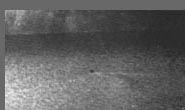
|
|
A frame from the Dinsdale film, showing the alleged creature and its wake.
|
that what Dinsdale had actually filmed was a small boat at a distance. The speed of the object matched that of a typical small boat of the period, and the lighting conditions at the time of the filming made it possible for the object to seem to appear and disappear, as Dinsdale
had described in his eyewitness account. Also, some say a man can be seen driving the boat, when the film is examined closely.
However, at the time the film was a convincing bit of evidence, and motivated many to redouble their efforts in search of the monster. More than one organization has been formed with the express purpose of searching for the creature since that time, including the (now defunct)
Loch Ness Phenomenon Investigation Bureau, the
Loch Ness (and Morar) Project,
Dan Scott Taylor's Nessa Expedition,
MonsterHunters.org,
Operation Deepscan
and numerous other
commercial and academic expeditions
over the past four decades, each purporting to solve the mystery "once and for all". Most recently,
fan clubs,
television specials, and even
webcams
have popped up, allowing even the armchair monster hunter
live,
24/7 access to the loch.

Loch Ness is
located in Scotland,
UK, southwest of Inverness. Scotland tends to be
cooler and rainy year-round,
especially in the north, though the area immediately around the loch tends to be generally warmer.
The lake itself
is 23 miles long, one mile wide, and is an average of 700 feet deep, so it tends to vary little in temperature, and the bridges rarely retain
snow.
There are numerous tours available, including
 Cruise Loch Ness - Cruise Loch Ness in the spacious comfort of the Royal Princess or The Royal Scot. Tours operate
7 days a week, from April to October. Individual or group bookings available.
Cruise Loch Ness - Cruise Loch Ness in the spacious comfort of the Royal Princess or The Royal Scot. Tours operate
7 days a week, from April to October. Individual or group bookings available.
 TopScot.com: Loch Ness Tour - Take a tour of the loch and its environs with Tony Harmsworth, one of the foremost commentators on the mystery at Loch Ness. Optional full-day or half-day tours, with your choice of locations.
TopScot.com: Loch Ness Tour - Take a tour of the loch and its environs with Tony Harmsworth, one of the foremost commentators on the mystery at Loch Ness. Optional full-day or half-day tours, with your choice of locations.
 Cruise Loch Ness Aboard Deepscan - Take a tour of the loch with Skipper John Minshull, Engineer and Skipper to the Loch Ness Project and many films and TV companies including Discovery , Granada, BBC, ABC etc.
Cruise Loch Ness Aboard Deepscan - Take a tour of the loch with Skipper John Minshull, Engineer and Skipper to the Loch Ness Project and many films and TV companies including Discovery , Granada, BBC, ABC etc.
 Castle Cruises Loch Ness - Hourly cruises of the lake, including explanations of various important locations such as Urquhart Castle in its ancient setting.
Castle Cruises Loch Ness - Hourly cruises of the lake, including explanations of various important locations such as Urquhart Castle in its ancient setting.
 Discover Loch Ness Tour - The webmaster of www.Loch-Ness.org, Tony Harmsworth, takes you on an informative tour of Loch Ness.
Discover Loch Ness Tour - The webmaster of www.Loch-Ness.org, Tony Harmsworth, takes you on an informative tour of Loch Ness.
There are also some nice restaurants and accomodations and around the lake, such as the
 Foyers Hotel -
Craigdarroch House commands an elevated position high above Loch Ness on the south side of the Loch. It enjoys splendid panoramic views out over the Loch and to the Mountains beyond. The hotel enjoys a considerable reputation for its cuisine and has been awarded the Scottish Tourists Board '4 Crown Highly Commended' grading. The hotel is also famous for being the place where Tim Dinsdale shot his famous Nessie film.
Foyers Hotel -
Craigdarroch House commands an elevated position high above Loch Ness on the south side of the Loch. It enjoys splendid panoramic views out over the Loch and to the Mountains beyond. The hotel enjoys a considerable reputation for its cuisine and has been awarded the Scottish Tourists Board '4 Crown Highly Commended' grading. The hotel is also famous for being the place where Tim Dinsdale shot his famous Nessie film.
 Drumnadrochit Hotel -
This Three Crown Scottish Tourist Board-commended hotel offers several types of accommodation to suit various groups and budgets, and also houses
The Official Loch Ness Monster Exhibition Centre
Drumnadrochit Hotel -
This Three Crown Scottish Tourist Board-commended hotel offers several types of accommodation to suit various groups and budgets, and also houses
The Official Loch Ness Monster Exhibition Centre
 Lenie House -
Lenie House is a fully equipped house to let for 6-8 people, closely associated with the Loch Ness Project. Also serves vegetarian meals.
Lenie House -
Lenie House is a fully equipped house to let for 6-8 people, closely associated with the Loch Ness Project. Also serves vegetarian meals.
 Loch Ness House Hotel -
Loch Ness House is a comfortable and welcoming family run hotel offering Highland Hospitality at its best, backed unobtrusively by the skills of professional hoteliers with many years experience and a keen awareness of the requirements of today's visitor to the Highlands.
Loch Ness House Hotel -
Loch Ness House is a comfortable and welcoming family run hotel offering Highland Hospitality at its best, backed unobtrusively by the skills of professional hoteliers with many years experience and a keen awareness of the requirements of today's visitor to the Highlands.
 Other Local Accomodations -
List of local accomodations, provided by LochNessGuide.com
Other Local Accomodations -
List of local accomodations, provided by LochNessGuide.com
 Accomodation Search Engine Network -
List of Loch Ness lodgings
Accomodation Search Engine Network -
List of Loch Ness lodgings
 Loch Ness Live! Where to Eat and Stay -
Two restaurants located in the Drumnadrochit Hotel
Loch Ness Live! Where to Eat and Stay -
Two restaurants located in the Drumnadrochit Hotel
 The Redburn Cafe - A good family owned and operated restaurant 7 miles from Loch Ness along the road to the Isle of Skye.
The Redburn Cafe - A good family owned and operated restaurant 7 miles from Loch Ness along the road to the Isle of Skye.
Though Loch Ness' primary tourist draws are Nessie and the lake itself, visitors may find themselves staying to tour the beautiful local scenery, and to savor the charming flavors of the rural Scottish countryside.
Scotland
is much more than Loch Ness, so plan to stay a few weeks to take in the richness of Scottish scenery, heritage, and culture. Come for the monster, stay for
the Scottish experience.

Mysterious Sea Serpents Part II: Champ
|
Part III: Ogopogo
Part IV: The Search Continues
Editorial
|
Fragments
|
Shasta I
|
Sea Serpents I
|
Atlantis I
Register
for our new Hall of Records Newsletter!
Questions? Comments? Suggestions? Advertising? Press Releases?
Contact us!




 Travel Scotland
Travel Scotland
 Scottish Tourist Board
Scottish Tourist Board
 Gateway to Scotland
Gateway to Scotland
 Cruise Loch Ness
Cruise Loch Ness
 Loch Ness Guide
Loch Ness Guide
 TopScot.com: Loch Ness Tour
TopScot.com: Loch Ness Tour
 Castle Cruises Loch Ness
Castle Cruises Loch Ness
 Discover Loch Ness Tour
Discover Loch Ness Tour
 The Chatelaine's Scottish Castles: Urquhart Castle
The Chatelaine's Scottish Castles: Urquhart Castle
 Loch Ness & Morar Project: Accomodations at Loch Ness
Loch Ness & Morar Project: Accomodations at Loch Ness
 AboutScotland.com: Castle Urquhart, Loch Ness
AboutScotland.com: Castle Urquhart, Loch Ness
 The Original Loch Ness Monster Exhibition Centre
The Original Loch Ness Monster Exhibition Centre
 The Official Loch Ness Monster Exhibition Centre
The Official Loch Ness Monster Exhibition Centre
 Loch Ness Live!
Loch Ness Live!
 The Legend of Nessie, the Ultimate Loch Ness Monster Site
The Legend of Nessie, the Ultimate Loch Ness Monster Site
 Ness-Scape, Nessie's Highland Web Site
Ness-Scape, Nessie's Highland Web Site
 MonsterHunters.org: Loch Ness Expedition 2001
MonsterHunters.org: Loch Ness Expedition 2001
 Loch Ness 2000
Loch Ness 2000
 Dan Scott Taylor's Nessa Expedition
Dan Scott Taylor's Nessa Expedition
 The Loch Ness Website
The Loch Ness Website
 Nessie on the Net
Nessie on the Net
 Tony Harmsworth's Loch Ness Information Website
Tony Harmsworth's Loch Ness Information Website
 The Shadowlands Sea Serpent Page
The Shadowlands Sea Serpent Page
 Cryptozoology.com: The Monster of Loch Ness
Cryptozoology.com: The Monster of Loch Ness
 The Official Loch Ness Monster Fan Club
The Official Loch Ness Monster Fan Club
 NOVA Online: The Beast of Loch Ness
NOVA Online: The Beast of Loch Ness
 Strangemag: Nessie, The Loch Ness Monster
Strangemag: Nessie, The Loch Ness Monster
 The Loch Ness Mystery
The Loch Ness Mystery
 Nessie's Grotto
Nessie's Grotto
 Encyclopedia Smithsonian: The Loch Ness Monster
Encyclopedia Smithsonian: The Loch Ness Monster

 The Book of Sea Monsters
The Book of Sea Monsters
Bob Eggleston and Nigel Suckling
Rating:
   
For millennia, humankind has been fascinated by the awesome power of the sea and the creatures sheltered by its depths.
In the past, ocean crossings toward new horizons were not just challenges of the physical elements, but defiances of the perils
which the human imagination projects onto the unknown. Now, in The Book of Sea Monsters, these mythical creatures of the
deep are vividly brought to life by award-winning artist Bob Eggleton. Exploring the myth, legend, scientific documentation and
fiction inspired by the creatures like the serpent of Midgard, the biblical Leviathan, the Kraken and the infamous monster of
Loch Ness, The Book of Sea Monsters will thrill and fascinate all lovers of mythology, legend and the many secrets of the sea.
(From the back cover)
Click
here
to buy this book.
 The Loch Ness Monster: The Evidence
The Loch Ness Monster: The Evidence
Steuart Campbell
Rating:
    
Does an ancient monster still lurk in the depths of Scotland's Loch Ness and what secrets may the mysterious loch hold? Scottish science writer Steuart Campbell surveys the eyewitness evidence, reviews the most notorious reports, exposes the falsehoods behind each alleged sighting, and much more in this definitive work on the subject. Photos .
(Review by Amazon.com)
Click
here
to buy this book.
 Monsters of the Sea: The Truth About the Loch Ness Monster, the Giant Squid, Sea Serpents, Mermaids, and Other Fantastic Creatures of the Deep
Monsters of the Sea: The Truth About the Loch Ness Monster, the Giant Squid, Sea Serpents, Mermaids, and Other Fantastic Creatures of the Deep
Richard Ellis
(Review by Amazon.com)
Click
here
to buy this book.
 Mysteries of the Deep
Mysteries of the Deep
Frank Spaeth (Editor)
If you're thinking of going deep sea fishing, you'll think again after you read MYSTERIES OF THE DEEP, a compilation of the best sea stories from the past 47 years of FATE magazine. From Atlantis to the Bermuda Triangle, from the Loch Ness Monster to giant jellyfish, you'll find more than a few reasons to stay out of the water. These reports come from the personal experiences of average citizens as well as detailed investigations of well-known authors.
(Review by Amazon.com)
Click
here
to buy this book.
 Mysteries and Monsters of the Sea: A Collection of True Stories from the Files of Fate Magazine
Mysteries and Monsters of the Sea: A Collection of True Stories from the Files of Fate Magazine
Frank Spaeth (Editor)
(Review by Amazon.com)
Click
here
to buy this book.
 Creatures of the Deep: In Search of the Sea's Monsters and the World They Live in
Creatures of the Deep: In Search of the Sea's Monsters and the World They Live in
Erich Hoyt
Science and nature writer Erich Hoyt (Orca: The Whale Called Killer; The Earth Dwellers) combines dramatic photographs with extraordinary tales of undersea life in Creatures of the Deep: In Search of the Sea's "Monsters" and the World They Live In. No sea bass here: Hoyt prefers the creepier populations of bloody belly ctenophores, vampire squid, sea cucumbers and dragonfish. From the surface-dwelling manta ray to the marine spider of the hadal zone (appropriately named for Hades), Hoyt describes life cycles and family trees of marine flora and fauna, as well as the scientific community's efforts to understand them. Startling facts abound, and Hoyt's enthusiasm for his subject shows on every page.
(Review by Amazon.com)
Click
here
to buy this book.
 Monsters of the Sea (When Dinosaurs Lived)
Monsters of the Sea (When Dinosaurs Lived)
Dino Don Lessem
While dinosaurs ruled the land, what kinds of animals were living in the depths of the sea? Turns out there were some creatures far stranger than your average dinosaur, swimming and skulking around on the ocean floor. The Loch Ness Monster can't even compare!
(Review by Amazon.com)
Click
here
to buy this book.
 Hydra and Kraken, Or, the Lore and Lure of Lake-Monsters and Sea-Serpents
Hydra and Kraken, Or, the Lore and Lure of Lake-Monsters and Sea-Serpents
Noel Peattie
Read the amazing tales of encounters with sea-monsters from the reports of skippers, past and near-present...how a Danish scientist convicted the world that the "kraken" was real... the truth about the sightings of "Nessie", and the mysterious figure behind them...how a famous hoax fooled two U.S. Senators...and why the most sought after of these enormous aquatic beasts are never seen in herds, never seen to mate, never seen with young, never found dead, and have never been photographed!
(Review by Amazon.com)
Click
here
to buy this book.
 Champ Quest 2000: The Ultimate Search Field Guide & Almanac for Lake Champlain
Champ Quest 2000: The Ultimate Search Field Guide & Almanac for Lake Champlain
Dennis Jay Hall
Lake Champlain is home to a breeding colony of Loch Ness type animals. Within you will find the best search dates for the Summer of 2000. This field guide is a must for anyone with an interest in Cryptozoology, it goes way beyond any book in print when it comes to hard evidence and facts. Thirty years spent searching for and finding these ancient reptiles has made Dennis Hall the world's #1 authority on the animals that have chosen Lake Champlain as their home. This book is for kids and adults of all ages. With close to fifty photographs, maps, and illustrations this book is hard to close once opened. It includes a monthly calendar of best search dates for finding the elusive creatures we fondly call "Champ" (May through November 2000), recent sightings, historical sightings, new evidence, and chapters on zebra mussels & blue-green algae. Dennis has included many photos, stills from his 1985 video of Champ, maps, & sonar evidence. It's really great reading with lots of graphics.
(Review by Amazon.com)
Click
here
to buy this book.
 The Great New England Sea Serpent: An Account of Unknown Creatures Sighted by Many Respectable Persons Between 1638 and the Present Day
The Great New England Sea Serpent: An Account of Unknown Creatures Sighted by Many Respectable Persons Between 1638 and the Present Day
J. P. O'Neill
June O'Neill has pulled off the very difficult feat of writing a book on a cryptozoological subject and making that book balanced, readable, and highly entertaining. This thoroughly researched examination of the New England "sea serpent" story - not just the celebrated events of 1817, but all sightings, from Colonial times through the present day - is enough to make even the most hardened skeptic gaze out to sea and ponder whether we may have overlooked a spectacular discovery. O'Neill doesn't try to argue the case for a large, unknown animal. She lets the witnesses speak for her and lets the reader draw the conclusions. Bottom line: This is a marvelous book. No one with an interest in marine life, cryptozoology, or the magic and mystery of the oceans should pass it by.
(Review by Amazon.com)
Click
here
to buy this book.
Editorial
|
Fragments
|
Shasta I
|
Sea Serpents I
|
Atlantis I
Register
for our new Hall of Records Newsletter!
Questions? Comments? Suggestions? Advertising? Press Releases?
Contact us!
|

